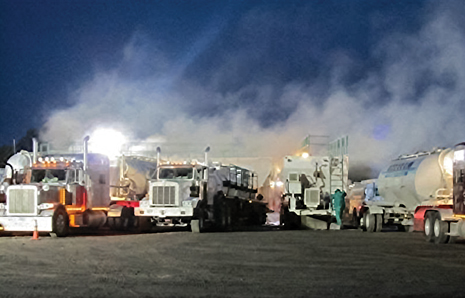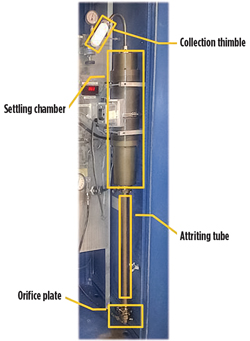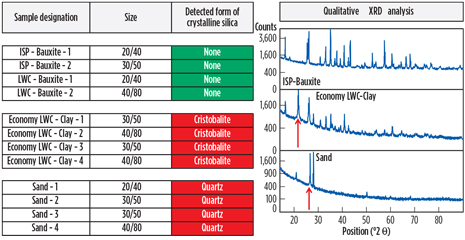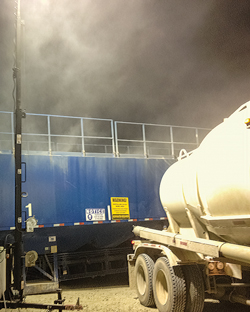Test proppants to mitigate respirable dust hazards
Sand generates respirable dust comprising crystalline silica, which is a concern for the hydraulic fracturing industry.
Horizontal drilling and multi-stage fracturing allow economical extraction of oil and gas resources from unconventional plays. With unprecedented growth in the last 10 years, the industry recognizes that sustainable growth is possible, only by the implementation of proven and environmentally safe solutions. Development of unconventional resources increases proppant consumption, and the amount of proppant used per wellsite was over 10 times higher in 2013 than in 2004. In 2014, wells utilizing 10 million lb of proppant/well are no longer an exception, but the new norm. Today, industry-accepted proppant qualification standards focus only on the mechanical strength and conductivity of proppants, as described in API 19-C and API 19-D testing procedures. Safety associated with proppant handling is not a part of those industry-accepted proppant selection requirements. PROPPANT-RELATED CHALLENGESThe growth of the horizontal fracturing industry reveals three major proppant-related challenges: on-time delivery of proppants to the site, safe handling of proppants at the site, and safe disposal of proppant waste from the site. On-time delivery of proppants to the site presents a logistical challenge. Significant numbers of railcars and trucks transport proppants from manufacturing or storage sites to the well. The industry recognizes that increasing traffic causes a greater carbon footprint and creates unwelcome disturbances in the local community. Development of a wide variety of engineering and logistical controls is underway by the industry to mitigate these concerns. After completion, disposal of waste materials, such as proppants, flowback products, or surface soil, occurs at local commercial landfills, and requires proper and environmentally sustainable solutions. Because natural minerals are components in sand and man-made proppants, they can contain trace levels of radioactive uranium, thorium, potassium, as well as decay products of radium and radon. For that reason, state and local HSE agencies classify proppants as naturally occurring radioactive materials (NORMs). Recently published research1 shows that while the presence of naturally occurring radioactive elements in sand or ceramic-based proppants is observable, proppants manufactured in the U.S. show minimal levels of radioactivity, well below state-regulated levels. Safe handling of proppants on the site is a concern, because of dust generation. Proppants experience repetitive mechanical handling from transport in railcars and trucks, to the point of final blending with the fracturing fluid. At each point of transfer, quantities of fine dust particles are generated that can affect worker safety. Due to increased of proppant consumption per site, the industry has a concern about a corresponding increase in the time-weighted average exposure of workers to dust. In 2012, the National Institute for Occupational Safety and Health (NIOSH) conducted a study2 regarding silica exposure in hydraulic fracturing, comprising 116 full-shift air samples on 11 hydraulic fracturing sites in five U.S. states using silica sand as proppant, Fig. 1. The measurements reveal that 79% of full-shift air samples exhibit a silica exposure level that is greater than the NIOSH recommended exposure limit (REL), which is 0.05 mg/m3, while 31% of all samples exhibit a silica exposure level that is 10 times greater than the NIOSH REL. These results prompted OSHA and NIOSH to issue, in 2012, a health hazard alert on Worker Exposure to Silica during Hydraulic Fracturing.3 On Sept. 12, 2013, OSHA issued a proposed rule to amend its existing standards for occupational exposure to respirable crystalline silica (78 FR 56274). This rulemaking proposes lowering the OSHA permissible exposure limit (PEL) to 0.05 mg/m3. When finalized, this permissible exposure level (PEL) level, calculated as an 8-hr time-weighted average, will match the current NIOSH REL level discussed in the previously cited NIOSH study. According to OSHA Assistant Secretary Dr. David Michaels, this standard could be finalized as early as 2016.4
RESPIRABLE PROPPANT DUSTWhether or not proppant will create crystalline silica containing respirable dust is highly dependent on the type of proppant used, and its chemical and crystalline composition. Sand and man-made ceramics are the two primary types of proppants employed by the hydraulic fracturing industry. Sand is a natural mineral, whose quality and composition depends upon its origin, but commonly consists of silicon dioxide in the form of quartz. On the other hand, man-made ceramic proppants are engineered materials typically manufactured from either clay (kaolin) or bauxite raw minerals. High-temperature thermal processing of kaolin and bauxite materials, also known as sintering, converts these minerals into their high-temperature crystalline forms. Thermal processing also changes the hazards associated with use of these materials. For example, the hazards associated with handling of kaolin clay are minimal, while high-temperature processing of kaolin clay creates cristobalite, a form of crystalline silica. One also needs to consider that not all dust created on site is considered respirable. NIOSH defines respirable dust as a portion of airborne dust that is capable of entering the gas-exchange regions of the lungs if inhaled or, by convention, a particle-size-selective fraction of the total airborne dust.5 In the case of crystalline silica, this means particles smaller than 10 µ.5,6 At this time, air sampling on the work site is the most common method used to determine the amount and health hazard of dust present on the work site. However, the air sampling method determines the level of exposure only after the fact, once exposure has already occurred. In an attempt to mitigate crystalline silica containing respirable dust risk on the wellsite, one might consider a proppant substitution option. Substitution of sand with alternative proppant types, such as man-made ceramics, is, when feasible, a preferred choice for mitigation of crystalline silicate risks associated with hydraulic fracturing.3 As man-made proppants are more expensive than sand, it is important to determine what type of ceramic proppant is a viable proppant substitution option for sand, to ensure that the risk is fully mitigated. OSHA, in its report, gives no recommendations on how to perform this assessment. LAB MEASUREMENTSaint-Gobain Proppants, among the largest ceramic proppant manufacturers, recently published a study that proposes a laboratory method to measure a proppant’s ability to create crystalline silica containing respirable dust, enabling a safe proppant substitution selection prior to proppant purchase. This method comprises three specific tests. First, a 10 L/min gas flowrate induces attrition of proppant particles as described under ASTM D 5757-95. The thimble of the apparatus (Fig. 2) collects any dust generated during this test.
Next, X-ray diffraction (XRD) analysis allows a qualitative and quantitative measurement of specific crystalline phases present in the collected dust. Finally, scanning electron microscopy of the dust provides visual confirmation that the dust particles meet the NIOSH standard definition of respirable dust particle size of less than 10 µ. By combining all three measurements, a simple and direct evaluation of proppant dust generation can be accomplished quickly in the laboratory, to establish if a selected proppant type is a viable substitution product for sand. Initial proppant testing published in the study1 compares dust generation of samples of sand, clay-based, economy lightweight ceramic proppants (Economy LWC), bauxite-based intermediate-strength proppants (ISP) and bauxite-based lightweight ceramics (LWC), Fig. 3.
Results demonstrate that all tested proppant samples generate dust during attrition. All samples of collected dust also show the presence of particles finer than 10 µ. However, XRD detects the presence of crystalline silica only in dust originating from sand and clay-based proppant samples. Bauxite-based proppant samples (both bauxite-based ISP and bauxite-based LWC) do not show presence of crystalline silica in generated dust samples. The study concludes that both sand and clay-based ceramic proppants have a potential for creating respirable dust containing crystalline silica. For that reason, clay-based ceramic proppants should not be considered as a viable substitution product for sand. On the other hand, dust collected from bauxite-based ceramic proppants contains no crystalline silica, so tested bauxite-based ceramic proppants can be considered as a viable substitution product for sand. ON-SITE DUST MITIGATIONAccording to OSHA, dust levels on hydraulic fracturing sites also can be mitigated by using a combination of engineering controls, work practices, protective equipment and worker training. Some operators are, already, actively investigating these options. A recent Marathon Oil field study examined the impact of current methodology used to deliver and offload sand on location, as it relates to grain damage and the amount of dust generated. According to Don Purvis, senior technical consultant at Marathon Oil, the study shows that pneumatic pressure used to transfer sand from bulk trucks to sand storage units on site has a large effect on the amount of dust generated, Fig. 4.
“Third-party contractors typically handle these transfers further complicating this issue,” Purvis explained. “Our study shows that gauges these companies use to monitor the transfer pressure are not carefully calibrated or tracked.” Purvis further reports that an excessive increase in pneumatic pressure can have an adverse effect on sand quality. “We are working with service companies to establish alternatives to pneumatic transfer, to eliminate damage to proppant and dust generated by this process. Meanwhile, we are working with our suppliers to establish a gauge calibration procedure to ensure that gauges used to monitor pneumatic pressure are reading accurately, as well as defining an acceptable pneumatic transfer pressure range to minimize proppant damage. The next step in Marathon’s efforts involves a collaboration with Saint-Gobain Proppants. These two companies are working together, to develop correlation factors between Marathon’s field studies and Saint-Gobain’s laboratory method, to more quickly and cost-effectively test a large number of conditions and variables relevant to transport, loading and unloading of proppants. The goal of both companies is to develop and share best practices with the Industry. CONCLUSIONSSand generates respirable dust comprising crystalline silica, which is a concern for the hydraulic fracturing industry. OSHA and NIOSH recommend exposure control methods, such as process modifications to eliminate hazards, product substitution, and engineering controls, as the primary focus of hydraulic fracturing industry safety and health programs. A new laboratory test method exists to evaluate proppants for respirable dust and hazardous materials. This test enables operators and service companies to evaluate which ceramic proppant types are a suitable proppant substitution option, prior to their purchase and use on site. Initial testing shows that only bauxite based ceramic proppants can be considered as a viable substitution product for sand. REFERENCES
|
- Shale technology: Bayesian variable pressure decline-curve analysis for shale gas wells (March 2024)
- EOR/IOR technology: Advanced shale oil EOR methods for the DJ basin (May 2023)
- The last barrel (April 2023)
- What's new in production (April 2023)
- ShaleTech- Permian shales: Production hits new high amidst talk of looming plateau (April 2023)
- ShaleTech: Marcellus-Utica Shales (February 2023)
- Applying ultra-deep LWD resistivity technology successfully in a SAGD operation (May 2019)
- Adoption of wireless intelligent completions advances (May 2019)
- Majors double down as takeaway crunch eases (April 2019)
- What’s new in well logging and formation evaluation (April 2019)
- Qualification of a 20,000-psi subsea BOP: A collaborative approach (February 2019)
- ConocoPhillips’ Greg Leveille sees rapid trajectory of technical advancement continuing (February 2019)







